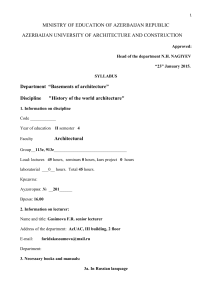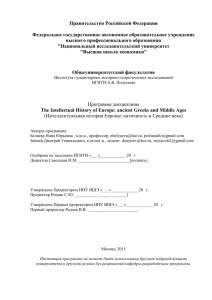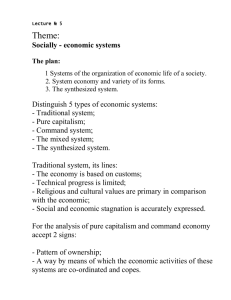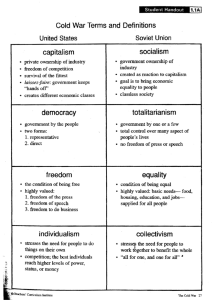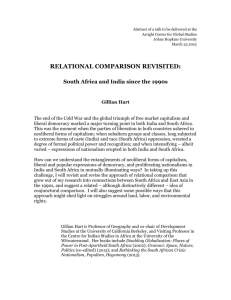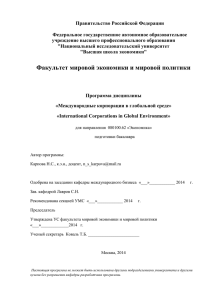Syllabus for ECONOMIC HISTORY
advertisement
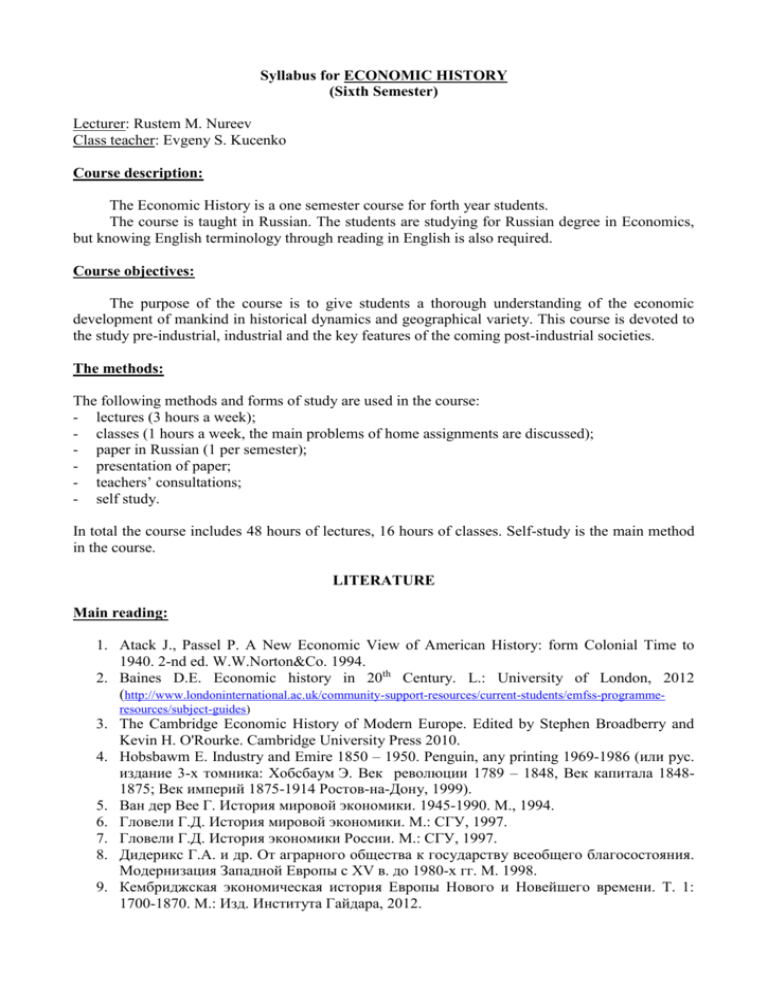
Syllabus for ECONOMIC HISTORY (Sixth Semester) Lecturer: Rustem M. Nureev Class teacher: Evgeny S. Kucenko Course description: The Economic History is a one semester course for forth year students. The course is taught in Russian. The students are studying for Russian degree in Economics, but knowing English terminology through reading in English is also required. Course objectives: The purpose of the course is to give students a thorough understanding of the economic development of mankind in historical dynamics and geographical variety. This course is devoted to the study pre-industrial, industrial and the key features of the coming post-industrial societies. The methods: The following methods and forms of study are used in the course: - lectures (3 hours a week); - classes (1 hours a week, the main problems of home assignments are discussed); - paper in Russian (1 per semester); - presentation of paper; - teachers’ consultations; - self study. In total the course includes 48 hours of lectures, 16 hours of classes. Self-study is the main method in the course. LITERATURE Main reading: 1. Atack J., Passel P. A New Economic View of American History: form Colonial Time to 1940. 2-nd ed. W.W.Norton&Co. 1994. 2. Baines D.E. Economic history in 20th Century. L.: University of London, 2012 (http://www.londoninternational.ac.uk/community-support-resources/current-students/emfss-programmeresources/subject-guides) 3. The Cambridge Economic History of Modern Europe. Edited by Stephen Broadberry and Kevin H. O'Rourke. Cambridge University Press 2010. 4. Hobsbawm E. Industry and Emire 1850 – 1950. Penguin, any printing 1969-1986 (или рус. издание 3-х томника: Хобсбаум Э. Век революции 1789 – 1848, Век капитала 18481875; Век империй 1875-1914 Ростов-на-Дону, 1999). 5. Ван дер Bee Г. История мировой экономики. 1945-1990. М., 1994. 6. Гловели Г.Д. История мировой экономики. М.: СГУ, 1997. 7. Гловели Г.Д. История экономики России. М.: СГУ, 1997. 8. Дидерикс Г.А. и др. От аграрного общества к государству всеобщего благосостояния. Модернизация Западной Европы с XV в. до 1980-х гг. М. 1998. 9. Кембриджская экономическая история Европы Нового и Новейшего времени. Т. 1: 1700-1870. М.: Изд. Института Гайдара, 2012. 10. Кулишер И. М. История русского народного хозяйства, 2012. – 760 с. 11. Мэддисон Э. Контуры мировой экономики в 1–2030 гг. Очерки по макроэкономической истории/ Пер. с англ. Ю.Каптуревского; под ред. О.Филаточевой. – М.: Изд. Института Гайдара, 2012. – 584 с. 12. Нуреев Р.М. Экономическая компаративистика. Terra economicus, 2010-2012, Т. 8, №№ 1-4, Т. 9, №№ 1-4, Т.10. №№ 1-3. 13. Нуреев Р.М., Латов Ю.В. Россия и Европа: эффект колеи (опыт институционального анализа истории экономического развития). Калининград, Изд-во РГУ им. И. Канта, 2010 Supplementary Reading: 1. Baines D.E. Economic history. L.: University of London, 1996. 2. Bently and Ziegler Traditions and Encounters: A Global Perspective on the Past. McGrawHill, 2000. ISBN: 0-07-243160-1. 3. Bulliet, Crossley, Headrick, Hirsch, Johnson and Northurp. The Earth and its Peoples. Houghton Miffin, 2001. ISBN: 0-618-00073-0. 4. Chandler A.D., Jr. Scale and Scope. The Dynamics of Industrial Capitalism. Сambridge, Mass.: Harvard University Press, 1990. 5. Eichengreen, B. Globalizing capital. A history of the international monetary system. (Princeton, NJ: Princeton University Press, 2008 second edition) 6. The Economic History of Britain since 1700. Ed. by Floud R. and McCloskey D. Second edition. vol. 1: 1700-1860; vol. 2: 1860-1939; vol. 3: 1939-1992. Cambridge University Press, 1994. 7. Gregory P.R., Stuart R.S. Russia and Soviet Economic Performance and Structure. 6th ed., 1998. 8. Kemp, T. The climax of capitalism. (London: Longman, 1990) 9. Kemp, T. Industrialisation in the non-Western world. (London: Longman, 1989) 10. Kenwood A.L. The growth of the International Economy, 1820-2000. 4th ed. London: Routledge, 1999. 11. McClellan III J. E., Dorn H. Science and Technology in World History: an introduction. Second Edition. The Johns Hopkins university press. Baltimore. 2006 12. McCloskey, Donald N. (1987). Econometric History. London: MacMillian 13. More C. The Industrial Age. Economy and Society in Britain, 1750-1985. Longmans, 1985. 14. Sterns, Adas, Schwartz and Gilbert. World Civilizations. The Global Experience. 15. Stiglitz, J. Freefall: free markets and the sinking of the global economy. (London: 16. Penguin Books, 2010)Addison/Wesley/Longman, 2001. ISBN: 0-321-03819-3 vol.1. 17. Аллен Р. Глобальная экономическая история: Краткое введение / пер. с англ. М.: Издво Института Гайдара, 2013. – 224 с. 18. Бродель Ф. Материальная цивилизация, экономика и капитализм / Пер с франц.: В 3 т. М., 1986-1992. 19. Гловели Г.Д. История экономических учений. М.: ЮРАЙТ, 2011. 20. Гусейнов Р. История экономики России. Новосибирск, 1998. 21. Дроздов В.В. Историко-экономические дисциплины. Учебное пособие. – М.: 2001. 22. История мировой экономики / Под ред. Г. Б. Поляка, А. Н. Марковой. М.,1999. 23. Кларк Г. Прощай, нищета! Краткая экономическая история мира / Пер. с англ. Николая Эдельмана. — М.: Издательство Института Гайдара, 2012. — 304 c. 24. Конотопов М.В., Сметанин С.И. История экономики. М., 1999. 25. Кулишер И. М. История экономического быта Западной Европы, 2012. - 644 с. 26. Мокир Д. Дары Афины. Исторические истоки экономики знаний/ Пер. с англ. Н.Эдельмана; под ред. М.Ивановой. – М.: Изд. Института Гайдара, 2012. – 408 с. 27. Нуреев Р.М. Очерки по истории институционализма. Ростов-на-Дону, 2010. 28. Тойбни А., Постижение истории / Пер с англ. М., 1991. 2 29. Фишер В. Европа: экономика, общество и государство. 1914 – 1980. М.: Гуманит. изд. центр ВЛАДОС, 1999. Sourses 1. Andrea and Overfield. The Human Record. Houghton Miffin, 2001. ISBN: vol.1. 0-61804245-8 and vol.2. 0-618-04247-4. 2. Maddison A. The World Economy: A Millennial Perspective. P., OECD, 2001 3. Reilly, Wimmer and Wolf. Worlds of History. A Comparative Reader, St.Martins Press, ISBN: vol.1. 0-312-15789-4 and vol.2. 0-312-15788-6. 4. The Reader to the Course "The Economic History".Part 1, 2. M., 2001, 2003. 5. Решения партии и правительства по хозяйственным вопросам. Т. 1-14. М., 1967-1983 Further readings 1. Aldcroft, D.H. The European economy, 1914–2000. (London: Routledge, 2001) 2. Allinson, G. Japan’s post war history. (London: Routledge, 1997) 3. Baines D. The Onset of Depression in Twentieth-Century Britain: Economic, Social and Cultural Change. Ed. by Johnson P., 1996. 4. Bairoch P. Economics and World History. Myths and Paradoxes. L., 1993 5. Blackford, M.G. The rise of modern business in Great Britain, the United States and Japan. (Chapel Hill, NC: University of North California Press, 1988) 6. Broadberry S.N. How Did the US and Germany Overtake Britain? A Sectoral Analysis of Comparative Levels, 1870-1990 // The Journal of Economic History, vol.58, No 2, June 1998, pp.375-407. 7. Cameron R. Geschichte der Weltwirtschaft. Bd. 2. Stuttgart, 1992. 8. Collins W.J., Williamson J.G. Capital-Goods Prices and Investment, 1870 – 1950 // JEH. 2001. № 1. Р. 59 – 94. 9. Eichengreen B. Globalizing Capital: A History of The International Monetary System. 1994. 10. Feinstein, C.H., P. Temin and G. Toniolo The world economy between the world wars. (Oxford: Oxford University Press, 2008) second edition 11. Fogel R. W. Railroads and American Economic Growth: Essays in Econometric History. 1964 12. Foreman-Peck, J. A history of the world economy: international economic relations since 1850. (New York: Harvester/Wheatsheaf, 1995) second edition 13. The Fontana Economic History of Europe. Editor Carlo M. Cipola. L., Glasgow, 1973-1978. 14. Gardner S. H. Comparative Economic Systems. 2nd. ed. 1998. 15. Gerschenkron A. Economic Backwardness in Historical Perspective: A Book of Essays. Cambridge: Belknap Press of Harvard University Press, 1962. 456 p. 24 cm. 16. Grafts N.F.R. The Human Development Index and changes in standarts of Living: Some historical comparisons // European Review of Economic History, 1, 1997, pp.299-322. 17. Hatton T.J., Williamson J.G. The Age of Mass Migration. N.Y., Oxford, Oxford University Press, 1998. 18. Jones, E., L. Frost and C. White Coming full circle. An economic history of the Pacific Rim. (Boulder, CO: Westview Press, 1993) 19. Krugman, P. The return of depression economics and the crisis of 2008. (London: Penguin Books, 2008) 20. Lee S. P., Passell P. Economic Growth Before 1860. A New Economic View of American History. W.W.Norton&Company, New York, London 21. Mathias P. The First Industrial Nation, Methuen, 2nd edition 1983. 22. Mosk, C. Japanese economic development: markets, norms, structures. (Abingdon: Routledge, 2008). 23. Naughton, B. The Chinese economy: transitions and growth. (Cambridge, MA: MIT Press, 2006) 3 24. North D., Thomas R.P. The Rise of the Western World: A New Economic History. Cambridge [Eng.] University Press, 1973. viii, 170 p. illus. 24 cm. 25. Piquet M., Histoire economique de l'Europe des dix: de la Seconde Guerre mondiale a aujourd'hui. P., 1985. 26. Walton G., Robertson R History of the American Economy. Harcourt Brace, 5th edition 1983. 27. Валлерстайн И. Исторический капитализм. Капиталистическая цивилизация. М.: Товарищество научных изданий КМК, 2008. 28. Вебер М. История хозяйства. М., 2001. 29. Вощанова Г. П., Годзина Г. С. История экономики. М., 2001. 30. История экономики / Под ред. О. Д. Кузнецовой и И. Н. Шапкина. М., 2000. 31. Красильщиков В.А. Превращения доктора Фауста (Развитие человека и экономический прогресс Запада). М.: «Таурус», 1994. 32. Лойберг М. Я. История экономики. М., 1997 33. Нуреев P.M. Политическая экономия. Докапиталистические способы производства. Основные закономерности развития. М.: Изд-во МГУ, 1991. 34. Розенберг Н., Бирдцелл Л.Е. мл. Как Запад стал богатым. Экономическое преобразование индустриального мира. Новосибирск, 1995. 35. Тимошина Т. М. Экономическая история зарубежных стран. М., 2000. 36. Тимошина Т. М. Экономическая история России. М., 1998. 37. Эггертссон Т. Экономическое поведение и институты. М.: Дело, 2001. 38. Экономическая история зарубежных стран / Под ред. В. И. Голубовича. Минск, 2000. Web-resourses to the course Professional organizations: The Cliometric Society (North Carolina State University) – http://cs.muohio.edu/Clio/; The International Economic History Association – http://cs.muohio.edu/IEHA/; Economic History Association (University of Kansas) – http://cs.muohio.edu/EHA/; Business History Conference – http://cs.muohio.edu/bhc/; European Historical Economic Society – http://www.eh.net/EHES/; European Business History Association (University of Toulouse 1 Graduate School of Management) – http://www.univ-tlse1.fr/EBHA/; Economic History Society (UK) - http://www.ehs.org.uk/. Journals Journal of Economic History (published by Economic History Association http://cs.muohio.edu/EHA/); Explorations in Economic History: http://www.apnet.com/www/journal/eh.htm; Economic History Review – http://www.blackwellpublishers.co.uk/ehs.htm (published by Economic History Society); European Review of Economic History – http://www.econ.ku.dk/ereh/ (издается European Historical Economic Society). 4 Economic History of Developing Regions (издательствоTaylor & Francis); Business History - http://www.frankcass.com/jnls/bh.htm; Journal of World-Systems Research: http://csf.colorado.edu/jwsr/ Data The Historical Data Archive at the University of Essex – http://hds.essex.ac.uk/ Great Britain Historical Database Online - http://hds.essex.ac.uk/gbh.asp The Great Britain Historical Database is a large database of British nineteenth and twentieth-century statistics. (Создатель сайта – University of Essex.) Special servers 1. Институциональная экономика http://ie.boom.ru/; http://institutional.narod.ru http://www.isnie.org. 2. Московский Либертариум: http://www.libertarium.ru/ 3. Центр аграрной истории: http://aghistory.ucdavis.edu/ 4. Центр экономической истории при Историческом факультете МГУ им. М.В. Ломоносова: http://www.hist.msu.ru/Labs/Ecohist/index.htm 5. Ассоциация «История и компьютер»: http://kleio.dcn-asu.ru 6. История США в МГУ: http://www.amstud.msu.ru/ 7. Архив философии истории: http://src.nsu.ru/filf/rpha/ 8. EH.Net (сервер спонсируется следующими организациями: the Business History Conference, The Cliometric Society, the Economic History Association, the Economic History Society, and the History of Economics Society) – http://www.eh.net/ 9. Economic and Social History (University of Oxford): http://www.history.ox.ac.uk/ecohist/index.htm 10. National Bureau of Economic Research (Working Papers – раздел «Economic History») – http://papers.nber.org/jel/N_index.html Grade determination: The students sit a final exam, estimated on a 100-point scale. The final grade point is constructed as follows: - Activity on lectures and classes - 15% - Mid-term test - 20% - Paper-10% - Presentation of paper-5% - Final exam - 50% Course outline: Introduction to economic history Subject and method of economic history. Human activities and the natural environment. Physical - geographical and economic - geographical environment. Economy and human development. Historical mentality and its impact on economic development. Values and patterns of economic behavior. Criteria of periodization. The multiplicity of approaches to periodization of economic development. Unilinear model of development. Model of cyclical development. Formational and 5 civilizational approaches: their advantages and disadvantages. Comparison of the real with the virtual. A comparative analysis. Systematic method. Models and types. Traditional approaches to economic history. New economic history and Cliometrics. Path dependency. PART 1. World Economic History. 1. Traditional Economy Evolving look at the stages of development. Primitive forms of farming. The Neolithic Revolution (by D. North and R. Thomas). Primitive command economy. Karl Polanyi on retseproktnosti and redistribution. Particularly archaic culture. The traditional command economy nationwide. KA Wittfogel of oriental despotism. Three agencies control. Out terror. Total submission. Total solitude. Asian cycle. Economic thought of ancient societies. Ancient society - the first experience of economic and political democracy. Antique policy. Slavery, its contents and basic shapes. The contradictions of the slave system. Ancient economic thought in the broad and narrow sense. Savings and chrematistics. Development of economic problems in the Roman law. Economic ideas of primitive Christianity. Agriculture. The dominance of the rural economy. Agrarian feudal economy.The manorial system. Unity of political and economic spheres. The forms of the feudal rent. Towns as urban centers: guilds. Medieval technology. Urban feudal economy. Economic culture of Western Europe in the Middle Ages. Common and distinct features of feudalism economic history (by the example of England). The decline of feudalism. 2. Market Economy 2.1. Capitalism genesis in Western Europe Non-economic derivations and consequences of economic growth from poverty to welfare. High value of humans’ lives ( Demographic effect: population growth, duration of life) Urbanisation. The role of political institutes. The industry and trade independence from political institutes. Laissez-faire policy. Markets as a powerful organising force . Different combinations of hierarchy and markets. An explanation from history: a western growth system. Growth derivations are innovations in trade, technology and organisation. The role of firms, markets and competition in the process of innovation. The emergence of an autonomous economic sphere and a merchant class. Innovation by extension of trade and discovery of new resources. Innovation by lowering the cost of production. Innovation by introducing new products. Uncertainty and Experiment. Diffusion of authority, experiment, and responsibility as experiment conditions. The development of property rights. Overcoming Resistance to Innovation: the diffusion of authority helps to initiate innovation, the judges independence Innovation in Organisation: Diversity (Forms of enterprise, Organisation of groups of workers, Organisation of scientists’ activity, Owners’ organisation) The evolution of institutions favourable to commerce. The Changing Legal Structure The creating of precedents (relatively to: insurance, bills of exchange, affreightment, sales agreement, partnership agreement, patent agreement, arbitrage agreement). The clarification of law from discretionary, ritual, religious adulterants (law, anchored like watch) 6 The development of money, credits, changind in the finance system. Bills (since the 13th century instead of chink, since the 17th century – negotiability of bills). Bills trading – evasion of church interdict on carrying charge. Insurance. The end of 12th century – the separating of insurance from financing (Italian). Absolutism. The union of noblesse and trade bourgeoisie. Substitution of Taxation for Confiscation (In England and Holland – the government loss of the rights for uncontrolled charge; Tax assessment – the right of Parliament) Formation of New Kinds of Enterprise. Double entry. Separating of industry transactions from personal transactions ( Legal entity; Credit practice – analysis of finance position and firm’s outlook). Economic association not based on kin relationship The Role of Reformation. The Formation of New social entrepreneurs class. Moral code, new ethics (industry fulfilling of the commitments fair punctuality). The Protestant ethic. Democratisation of the church in the interests of the bourgeois Political prerequisites. Political pluralism in Europe as the beginning of growth An example from history: Main features of formation of capitalism in England and Spain (comparative analysis) Main factors of capitalism genesis: the controversy. Common and distinct features of capitalism genesis (by the example of Great Britain). 2.2. Industrial revolution and economic growth of the industrial society (by the example of Great Britain in XVIII – XIX) Prerequisites of the genesis of the industrial system. Industrial revolution. Rates and factor of economic growth. Courses of financing investments. Stages of industrial revolution. The results of industrial revolution. The factories. Labour movement. Working time regulation. Diversity of organization: the corporation. General corporation laws. Great Britain: the historical features of the economic development. “The Great Transformation.” The industrial revolution – rise of the industrial society. Economic culture of Modern Age. Common and distinct features of Modern Age economic development (by the example of Great Britain). Controversial problems of the industrial revolution. 2.3. Off-center relations in the Modern Age (by the example of American Slavery) The American Revolution. American economy in the first half of the XIX century. Offcenter relations in the Modern Age. Plantation slavery of the Modern Age. American slave system and its productivity. The collapse of plantation slavery. The civil war. Controversial problems of the off-centre relations analysis. Westward expansion in the USA in the XIX century. Agriculture in the USA. Banking and finance. 2.4. Developed Industrial Society Free competition era decline. Monopolies emergence. Antitrust laws. QWERTY-effects. Common and distinct features of imperialism development. (by the example of Great Britain and USA). Controversial problems of economic history of imperialism era analysis. British industry and British economy 1870-1914. International trade and colonial policy. British imperialism. Imperialism of the others countries. The twofold mission of capitalism in colonies: Destroying (The Higher crafts, the Land and tax Reform). and Creating: (The development of the “trade” agriculture; the creation of a “European-like” industry and plantations). The peculiarities of the so called previous capital accumulation process in colonies. The feudal methods of the bourgeoisie private ownership fostering. "Nonproletarian pauperization." The false market and capitalist economy’s development. Interconnection with the 7 foreign markets, but not with the internal one. The reversibility of the industry’s development stages. The colonial economy braking role 2.5. The First World War and its economic consequences Economic reasons for the First World War. “Military capitalism” of the First World War. Economic results of the war. Capitalist World-Economy in the Interwar Period. Common and distinct features of the developed countries economic history in the 1920s. 2.6. The Great Depression American and British economies in the twentieth century. Slump and recovery in British and the USA 1929-39. The Great Depression : the end of the free competition era. Discussion about the reasons for the Depression. FRS policy in the period of the Depression. The development of government control as a reply to the “challenge” of the Great Depression – common and distinct features. Key measures of the “New Deal” and their consequences. Keynsian revolution. Government intervention in the British economies in the twentieth century. 3. Mixed Economy 3.1. Economic growth after the Second World War. Its peculiarities in countries of the Capitalist World-Economy core Economic results of the Second World War. The forming of national mixed economy models (1950s - 1970s). Mixed economy. General features and distinguish between American, Japanese and West European model of marked economy. 3.2. Postindustrial Society Concepts of post-industrial society. The scientific and technological revolution. The increasing role of the service sector. Information and telecommunications. Knowledge as a limiting factor. The Future of Work. Human capital and its development. General productive forces. Social capital. Transnational economy. The emergence of global problems. Progress of economic and social progress. 3.3. Economic development of the periphery of contemporary World-System in the second half of XX Prerequisites and peculiarities of the periphery capitalism formation. Main problems of the development countries: food problems, brain drain, dept problem etc. Different models of the development: keynsian, neoclassical, institutional and radical. Evolution of “overtaking development” theoretical models. Evolution of “overtaking development” practical programs. New industrial state. Perspective of the development. PART 2. Economic History of Russia. 4. Pre-Command Economy 4.1. Russia in the Middle Ages 8 Specific factors of Russian economic history. Russia between Europe and Asia. Moscow kingdom. Power-property as economic institute. Russian and foreign historians: evolution of views on socio-economic development of Russia under the Old Regime. 4.2. Contradiction of Catch development in pre-revolutionary Russia Modernization and demodernization during the era of Peter The Great. Russian mercantilism. The State as a major power of the social and economic development. Selective Borrowing from the West-European capitalist experience. Asynchrony in the XVII – 1-st half of. XIX cc.: the capitalist development and the strengthening of serfdom. The Technical and Economic modernization to The Monarchy and The Nobles Support. Liberal reforms in 1762-1861. Russia at the close of XIX – beginning of XX at the second stage of capitalism development. The Retrogressive Role of The Nobles in Economic, Social and Political Life. The Weakness of the National Bourgeoisie in Economic, Social and Political Life. The Strong Acuity of social contradictions and contrasts. 5. Command Economy 5.1. The Rise of command economy USSR Economic reasons for 1917 revolution. Economy governmentalization during the civil war. Military communism. Centralized food dictatorship. Labor militarization. Low wage rate as the main reason of desertion. Growth of shadow economy. Dichotomy of government centralized barter economy and private dissipated market Achievements and failures of the New Economic Policy. Administrative-planned system of Stalin. Process of increasing government role in the economy and the administrative-plan system genesis. Spurred industrialization. Making the administrative-plan system under spurred industrialization. Feature of spurred industrialization (Wide use of manual labour; Universal equipment; New building construction; ). Gigantomania ( prevalence of huge scale in economy): economies of scale; communistic oriented; comparative simplicity in planing and procurement of production: notably from "above". Conflicts between regional and national requirements increase in province. Long term building Inflation. Monopoly in production; Problems in procurement secondary universalization of production. Total collectivization. The administrative-plan system genesis. General planning based on industrial projects. “striking nose and non striking tail” (L.N. Kriczman). Incomplete balance and partial disproportions on pre-war five-years and early post-war five-years. Integrated multiple-choice planning. 5.2. The Main Features of command economy USSR Method of balances.: Soviet economy structure. Command model. Permanently conservative of the planned indicators. Decrease in growth rate of National Income. Monopolization. Features of administrative monopoly. Difference from ordinary monopoly: Based on state property; Run under production deficit and limited market; Run under closed economy (based on state foreign trade monopoly), Protected from competition: ( Substitutions; Technological progress; Foreign competitors). Reasons for technological progress deceleration. Monopoly in all industries. Absence of economic responsibility of ministries for technological progress. No correlation between R&D budget and implementation of new inventions. 9 Deficit economy and its “shadow”. Free consumer choice and its limitation in the time of socialism. Deficit and quality. Requiring payment and free of charge systems. Allocation by “common mess”. Queues. The queue in a case of the fixed price. Allocation vs demand price and queue length. Queue in case of indefinite equilibrium. Allocation vs demand price and queue length when the equilibrium price is ineffective. Time in the queue elasticity of demand. Queue types and its discipline. Mediation and speculation. Black market. Rationing and its types. Ration card system. Rationing by means of checks. Rationing by means of coupons. The reform in retail prices. Increase of the government price followed by the increase of income. Government price increase followed by fully compensating income increase The choice of forms of the social support (grants, increase in money income) Soviet command economy: crisis and collapse. 6. Post-Command Economy (Transition economy in Russia at the End of the XXth and in the beginning of XXIst century) Russia in the third echelon of capitalism development. Formation of market institutions in the Soviet shadow economy. Formation of market institutions in the Soviet legal economy. Privatization of 1992 - 1995 years. and its outcome. The main features of contemporary institutional environment: new opportunities and new constraints. A modern adaptation process and the problems of institutionalization of new rights and rules. Households in a transition economy: non-market adjustment to the market. The problems of the middle class in Russia. The Rise and Fall of barter. Paternalistic union employees and entrepreneurs: conflict and consensus. Features of national wages. Post-Soviet trade unions: the new institutional framework. "Hidden" unemployment as a social and economic problem. Economy racketeering. Obstacles to the legal protection of property rights. The negative image of Russian business. Government in a transition economy as a generator of the institutional environment. "Revolution from above" and its consequences. The problem of "institutional inadequacy" of the Russian state. Residual state ownership: issues of good governance. Of the welfare state redistribution of the welfare state: the germs of new features. Direction of improving the protection of property rights. Conditions of formation of the competitive environment. Attempts to stimulate economic growth. Concept of modernization of the Russian economy: their advantages and disadvantages. Teaching hours for topics and activities: No 0. 1. 2. 3. 4 5 6 Introduction. What is economic history? Part 1 Traditional Economy Market Economy Mixed Economy Part 2 Pre-Command Economy The Command Economy. Post- Command Economy. TOTAL: 10 Contact hours i. e. Lectures Classes 7 4 1 Selfstudy 2 12 33 17 6 18 8 2 5 3 4 10 6 10 9 8 96 4 4 4 48 2 2 1 16 4 3 3 32 TOTAL (hours) Topics titles
